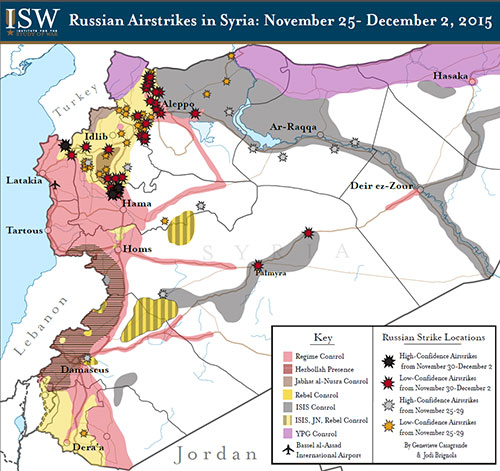
This map was originally published by the Institute for the Study of War on 4 December, 2015.
Russian air operations in Syria continue to pursue the preservation of the Assad regime. Spokesman for Combined Joint Task Force Operation Inherent Resolve Colonel Steve Warren commented on Russia’s most recent statements regarding its operations in Syria, stating that “Everything they are doing is to support Assad, to keep Assad in power… Every time the Russians conduct an operation that extends or helps extend Assad’s hold on power is yet another day that Syrian civilians will suffer under the boot of Bashar al-Assad.”
Russian airstrikes largely targeted rebel-held terrain in Aleppo, Idlib, and Hama Provinces from November 30 to December 2. Russian warplanes concentrated in the northern Aleppo countryside, primarily striking targets along a key rebel-held ground line of communication (GLOC) necessary for the delivery of Turkish support into Aleppo City. This rebel supply line remains highly vulnerable as ISIS continues to advance in the area, capitalizing on the intensity of the Russian strikes. ISIS seized at least four villages east of the strategic border town of Azaz on December 2, bringing ISIS within six miles of the supply route. Meanwhile, regime forces supported by Iranian-backed proxy forces and Russian airstrikes continue to fix Syrian opposition fighters south of Aleppo City, likely hindering large-scale reinforcements from bolstering the northern rebel frontline against ISIS. The Syrian regime and ISIS have historically leveraged each other’s offensives in order to advance against rebel forces in the north of Aleppo City. Russian airstrikes, regime ground operations, and the most recent ISIS offensive threaten to incur major losses for rebel forces in Aleppo.
Russian airstrikes continue to punish local Syrian populations through the targeting of key civilian infrastructure in rebel-held territory. The Russian Ministry of Defense (MoD) released a video claiming to strike an “oil storage” facility on December 2. However, analysis by investigative journalists confirmed that the strike had in fact hit a water treatment facility located in eastern Aleppo. The strike reportedly produced significant damage to the facility and more than 1.4 million people in rural Aleppo suffered interruptions in their water supply as a result. Further analysis of Russian MoD strike footage as well as local activists reporting revealed that Russian airstrikes also targeted grain silos in the countryside of Idlib and Aleppo.
The following graphic depicts ISW’s assessment of Russian airstrike and cruise missile locations based on reports from local Syrian activist networks, Syrian state-run media, and statements by Russian and Western officials. This map represents locations targeted by Russia’s air campaign, rather than the number of individual strikes or sorties.
High-Confidence reporting. ISW places high confidence in reports corroborated both by official government statements reported through credible channels and documentation from rebel factions or activist networks on the ground in Syria deemed to be credible.
Low-Confidence reporting. ISW places low confidence in secondary sources that have not been confirmed or sources deemed likely to contain disinformation.
Genevieve Casagrande is a Research Assistant at the Institute for the Study of War where she focuses on Syria with an emphasis on the Syrian opposition. She previously worked with The Carter Center as a Conflict Analyst with the Conflict Resolution Program’s Syria Conflict Mapping Project and the Syria Transition Options Initiative. While at ISW, Genevieve has contributed to such publications as “The YPG Campaign for Tel Abyad and Northern ar-Raqqa Province” and “ISIS Captures Ramadi.”
For more information on issues and events that shape our world, please visit ISN Security Watch or browse our resources.

